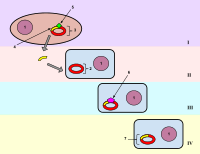
Photo from wikipedia
The competence regulon of pneumococcus regulates both genetic transformation and virulence. However, competence induction during host infection has not been examined. By using the serotype 2 strain D39, we transcriptionally… Click to show full abstract
The competence regulon of pneumococcus regulates both genetic transformation and virulence. However, competence induction during host infection has not been examined. By using the serotype 2 strain D39, we transcriptionally fused the firefly luciferase (luc) to competence-specific genes and spatiotemporally monitored the competence development in a mouse model of pneumonia-derived sepsis. In contrast to the universally reported short transient burst of competent state in vitro, the naturally developed competent state was prolonged and persistent during pneumonia-derived sepsis. ABSTRACT The competence regulon of pneumococcus regulates both genetic transformation and virulence. However, competence induction during host infection has not been examined. By using the serotype 2 strain D39, we transcriptionally fused the firefly luciferase (luc) to competence-specific genes and spatiotemporally monitored the competence development in a mouse model of pneumonia-derived sepsis. In contrast to the universally reported short transient burst of competent state in vitro, the naturally developed competent state was prolonged and persistent during pneumonia-derived sepsis. The competent state began at approximately 20 h postinfection (hpi) and facilitated systemic invasion and sepsis development and progressed in different manners. In some mice, acute pneumonia quickly led to sepsis and death, accompanied by increasing intensity of the competence signal. In the remaining mice, pneumonia lasted longer, with the competence signal decreasing at first but increasing as the infection became septic. The concentration of pneumococcal inoculum (1 × 106 to 1 × 108 CFU/mouse) and postinfection lung bacterial burden did not appreciably impact the kinetics of competence induction. Exogenously provided competence stimulating peptide 1 (CSP1) failed to modulate the onset kinetics of competence development in vivo. The competence shutoff regulator DprA was highly expressed during pneumonia-derived sepsis but failed to turn off the competent state in mice. Competent D39 bacteria propagated the competence signal through cell-to-cell contact rather than the classically described quorum-sensing mechanism. Finally, clinical pneumococcal strains of different serotypes were also able to develop natural competence during pneumonia-derived sepsis.
Journal Title: Infection and Immunity
Year Published: 2020
Link to full text (if available)
Share on Social Media: Sign Up to like & get
recommendations!